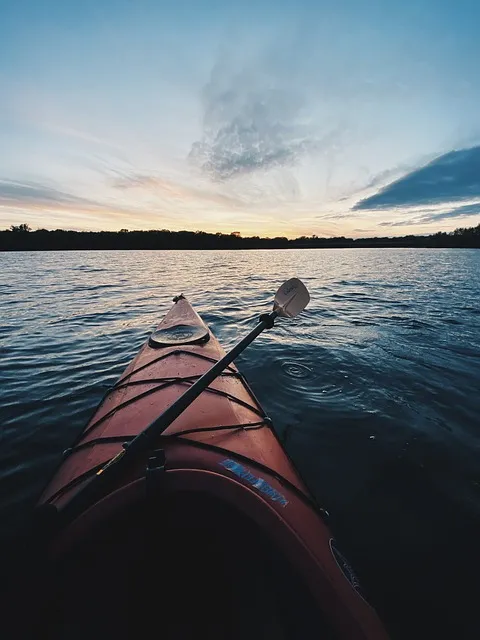Choosing a stable yet performance-oriented fishing kayak is key to enhancing your angling experience. A wider hull width improves primary stability, making it harder for the kayak to tip over, while thoughtful design features such as ergonomic seats, adjustable footrests, and strategic storage compartments contribute to comfort and efficiency during long excursions. Safety is paramount, and anglers should always wear a US Coast Guard-approved PFD, carry essential safety gear, and stay informed about weather conditions. Selecting the appropriate paddle, using high-quality fishing rods with a variety of lures or baitcasters, and employing stealthy and maneuverable paddling techniques can significantly improve your catch rate. Always remember to prioritize safety above all else to ensure a successful and enjoyable kayak fishing trip.
Embarking on a paddling adventure, whether on serene lakes or rushing rivers, can be an angler’s dream. Choosing the right fishing kayak is paramount for navigating these waters effectively and comfortably. This article delves into the quintessential features of top-tier fishing kayaks, tailored for diverse conditions, and offers insights on enhancing stability and comfort for those extended paddles. Discover the best models, essential gear, and smart strategies to elevate your angling experience. Safety remains a cornerstone in kayak fishing, ensuring you reap the rewards of your aquatic endeavors with peace of mind. Dive into the comprehensive guide designed to make your next lake or river paddling trip a resounding success.
Understanding the Essentials of Fishing Kayaks for lakes and Rivers

When embarking on a paddling adventure in lakes or rivers, selecting the right fishing kayak is paramount for comfort, safety, and effectiveness. A fishing kayak designed for these water bodies should be stable yet maneuverable to navigate through various conditions. Kayaks intended for fishing typically come with features tailored to anglers, such as ample deck space for casting lines, rod holders for keeping your rods secure while you paddle, and compartments to store gear safely and dryly. For lake enthusiasts, a kayak with a larger hull and a rudder system can offer superior stability and tracking, allowing for longer excursions without battling the current. On the other hand, river-specific fishing kayaks might have shorter, more nimble designs to handle tight turns and shifting water flows. In both cases, the sit-on-top design is often preferred due to its ease of entry and exit, as well as its capacity for customization with aftermarket accessories like live wells or fish finders.
Furthermore, when choosing a fishing kayak for lakes or rivers, consider the materials from which it’s constructed. High-density polyethylene (HDPE) is a durable, low-maintenance option that resists dings and scratches. For those who prioritize performance and portability, lightweight and high-performance kayaks made from advanced composite materials may be the ideal choice. These materials not only reduce weight for easier transport but also enhance speed and responsiveness. Whether you’re an angler targeting the serene depths of a lake or the dynamic flow of a river, selecting the right fishing kayak equipped with thoughtful features will undoubtedly enrich your paddling and angling experience.
Key Features to Look for in a Quality Fishing Kayak

When selecting a fishing kayak tailored for paddling in lakes and rivers, several key features distinguish a quality craft from one that might leave you adrift. Firstly, stability is paramount, especially when casting lines or maneuvering in windy conditions; a wider hull typically offers greater stability. The design of the kayak’s hull also plays a crucial role in its performance; a V-shaped hull cuts through water efficiently for tracking straight, while a flat hull provides more lateral stability for casting and angling.
Additionally, fishing kayaks are equipped with features that cater specifically to the angler’s needs. Adequate storage compartments for gear and catches are essential, as is the presence of rod holders, which allow you to troll or set up rods while keeping your hands free for paddling. The kayak should also be fitted with ample tie-down points to secure your equipment safely during transit. Furthermore, comfort is a significant consideration; high-quality seats with adjustable footrests ensure a comfortable fit for all-day excursions. Lastly, when considering a fishing kayak for lake and river paddling, materials and construction are critical; a rugged, rotomolded polyethylene hull offers durability and resists the wear and tear of frequent use in various water environments. By prioritizing these features, anglers can select a kayak that not only enhances their fishing experience but also provides safety and convenience on the water.
The Best Fishing Kayak Models for Different Water Conditions

When venturing out into different water conditions for fishing, having the right fishing kayak is paramount. For calm lakes and sheltered bays, a stable, lightweight kayak such as the Hobie Mirage Pro Angler 12 is ideal. It boasts a large standing platform, ample storage space, and revolutionary mirage drive technology that allows for hands-free maneuvering, perfect for anglers who want to explore and cast effortlessly from any angle. Its wide hull provides exceptional stability, making it suitable for beginners and seasoned paddlers alike.
Conversely, river fishing demands a kayak designed for maneuverability and durability. The Old Town Predator MX is tailored for whitewater and fast-moving streams. It features a rugged design with a pronounced rocker for responsive turns and a shorter length to navigate through narrow channels and rapids. Its rotomolded construction ensures longevity and resilience against the abrasions often encountered in river environments. Both kayaks are equipped with fishing-centric features such as rod holders, built-in cooler storage, and transducer scupper for fish finder integration, making them versatile choices for any angler looking to paddle and fish in different water conditions.
Tips for Enhancing Stability and Comfort During Long Paddles

When embarking on long paddles in a fishing kayak, maintaining stability and comfort is paramount for an enjoyable and successful outing. To enhance stability, consider the kayak’s width and hull design, which are key factors that affect how well your vessel resists tipping. A wider kayak generally offers greater primary stability, making it less prone to capsizing when not in motion. However, for faster-moving water, a narrower kayak might be necessary, so balance is key; choose a model that provides a good compromise between width and performance.
In terms of comfort, especially during extended paddles, ergonomic considerations are crucial. High-quality fishing kayaks come equipped with adjustable seats and breathable padding to prevent discomfort from prolonged sitting. Additionally, outfitting your kayak with thoughtfully placed storage compartments not only keeps your gear secure but also helps maintain a lower center of gravity, further contributing to stability. Footrests designed for different body types ensure proper leg positioning, reducing fatigue and allowing for efficient paddling strokes. Lastly, selecting the right paddle for your height and stroke style can significantly reduce strain on your joints and back. By carefully choosing and equipping your fishing kayak with features that promote stability and comfort, you’ll be well-prepared to tackle long paddles on lakes and rivers with ease.
Essential Gear and Accessories to Complement Your Fishing Kayak

When embarking on a paddling adventure in lakes or rivers, outfitting your fishing kayak with the right gear and accessories can significantly enhance both your experience and safety. A well-equipped kayak is key to making the most of your time on the water. Start with a reliable Personal Flotation Device (PFD) that’s comfortable for long periods and offers ample storage for essential items. Sun protection, in the form of hats, sunglasses, and waterproof sunscreen, should be part of your routine, especially on bright days.
In addition to safety gear, consider a high-quality paddle that matches your height and stroke style for optimal performance. A dry bag is essential for keeping personal effects like wallets, phones, and keys safe and dry. For anglers, a set of quality fishing rods with a variety of lures or baitcasters can make the difference between an average outing and a memorable catch. Additional accessories such as a cooler for your catch, a paddle leash to keep your paddle within reach if you capsize, and a compact, portable seat cushion for added comfort are highly recommended. Lastly, ensure that you have the necessary tools for basic repairs and maintenance, such as a multi-tool or a puncture repair kit for your kayak, to handle any unexpected issues on the water. With these essentials at hand, your fishing kayak will be primed for successful and enjoyable excursions on the lake or river.
Strategies for Effective Fishing from Your Kayak

When venturing out in your fishing kayak, mastering the art of effective angling from this unique vantage point is both a skill and an adventure. To maximize your success on the water, it’s crucial to understand how the kayak’s stealth and maneuverability can be leveraged for a successful catch. Firstly, choose a fishing kayak designed with stability and tracking in mind; this ensures you can navigate quietly and efficiently to approach fish without spooking them. Paddles with feathered blades can reduce noise as they cut through the water, further enhancing your stealthy approach.
Positioning is key when fishing from a kayak. Anglers should be mindful of the wind and current, using these elements to their advantage by drifting or paddling into the most productive areas. Utilize your kayak’s flexibility to cast towards structure like submerged trees, rocks, or drop-offs where fish are likely to be holding. Employing a variety of lures and baits tailored to local species and conditions can also increase your chances of a bite. Always remember to keep a low profile on the water by avoiding sudden movements and staying aware of your surroundings. By combining thoughtful paddling techniques with careful observation and patience, your fishing kayak can become an extension of your angling skills, allowing for a rewarding experience on lakes and rivers alike.
Safety Measures to Keep in Mind When Kayak Fishing on Lakes and Rivers

When embarking on a kayak fishing excursion in lakes and rivers, prioritizing safety is paramount to ensure a memorable and incident-free experience. A well-equipped fishing kayak should be your starting point; it must be designed with stability, maneuverability, and tracking capabilities suitable for the waterbody you’re venturing into. Always wear a personal flotation device (PFD) that fits snugly and is US Coast Guard-approved. Additionally, carry a reliable sound-producing device to alert rescuers in case of an emergency. Paddlers should be well-versed in basic rescue techniques and be prepared with the necessary safety gear, including a throw bag, paddle leash, and a spare paddle. It’s crucial to check weather conditions before and during your trip; sudden changes can alter your plans and potentially pose dangers on the water. Lastly, inform someone ashore about your planned route and expected return time, so they can raise an alarm if you fail to check in as scheduled. Adhering to these safety measures will help you enjoy the tranquility and thrill of fishing from a kayak while staying safe on the water.
